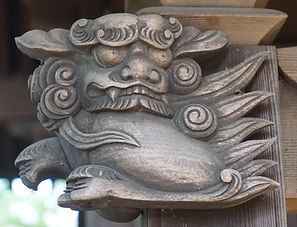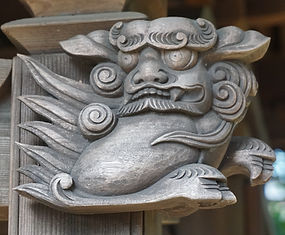普通の外にいくつかの著名な品質を持っている、と畏敬の念を起こさせるあるいかなるビーイングは、カミと呼ばれています。

Tōkyō-to, Setagaya-ku, Higashi Tamagawa 1-32-9 東京都世田谷区東玉川1-32-9
August 18, 2018
東玉川神社
Higashitamagawa Jinja
Home page: none

Enshrined Kami:
Main
(Note: numbers in parentheses after kami names
refer to position in How Many Kami table)
Tateminakata-no-mikoto (111) 建御名方命
Ōyamakui-no-kami 大山咋神
From Merged Shrines
None
In-ground Shrines:
Mitake Jinja 御嶽神社
Inari Jinja 稲荷神社
Annual Festival: August 23


Nearest station: Yukigaya-ōtsuka Tōkyū Ikegami Line:
History
Until 1889 the area in which Higashitamagawa Jinja is located was known as Todoroki-mura Suwa-bun (等々力村諏訪分). The Suwa-bun name derived from the presence of a Suwa Jinja, the betto-ji for which was a temple which no longer exists, Saikōji. In 1889 Todoroki-mura was merged with several other villages and the new entity was renamed Tamagawa-mura.
Two decades later, three years after the enactment of the Jinja Goshi order in 1906, Suwa Jinja, along with two other shrines, was merged with a nearby Kumano Jinja: this was subsequently renamed Tamagawa Jinja. Around this time the area began to experience substantial population growth and in 1932 Setagaya-ku was established. As part of this,
Higashitamagawa-chō was set up independently of Tamagawa-mura: along with this there was a movement to restore Suwa Jinja and the rights to the shrine’s grounds were confirmed. The previous year, 1931, the prayer hall and main hall of Shibuya Hikawa Jinja were rebuilt and the old ones were donated to Tamagawa Jinja in 1939 and 1940 respectively. In 1941 Hiei Jinja in Noge was merged into Tamagawa Jinja and the new entity was renamed Higashitamagawa Jinja.
Description
As the main hall has only been at Higashitamagawa Jinja since 1939 it is not suprising that it is much older than the shrine; the Shinpen tells us that it was built in 1605 during the reign of the second Tokugawa Shōgun, Hidetada (秀忠). Of particular interest is the kōhai above the stairs leading to the haiden. On it there is a charcoal painting of a blazing dragon (kaen ryūjin, 火焔龍神). When I visited the shrine it was unattended and I was unable to access it and get a good photo of the painting. This photo shows its bottom part, I will be adding a full photo in due course.
(Click on images to expand them)

























%20(1).jpg)